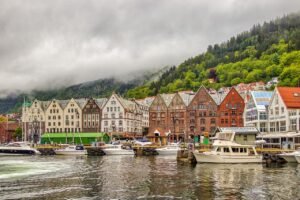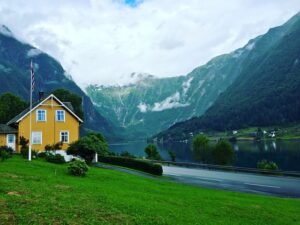

Appreciating Art in German: Vocabulary for Museums
Learning a new language involves more than just memorizing vocabulary and grammar rules. It also requires an understanding of the culture and the ability to express oneself in various contexts. One area that often gets overlooked in language learning is art appreciation. However, learning art vocabulary in German can greatly enhance your language learning experience.
Art is a universal language that transcends borders and cultures. By studying art in German, you not only expand your vocabulary but also gain insight into the rich artistic traditions of the German-speaking world. Whether you are interested in classical paintings, contemporary sculptures, or avant-garde installations, learning art vocabulary in German will enable you to appreciate and discuss these works with a deeper understanding.
Table of Contents
ToggleVocabulary for Art Styles and Movements in German
Art is constantly evolving, with different styles and movements emerging throughout history. Learning the German words for popular art styles and movements will allow you to identify and discuss these works with ease.
Some of the most well-known art styles and movements include:
– Renaissance (Renaissance): This period of European history marked a revival of interest in classical art and culture. Artists such as Leonardo da Vinci and Michelangelo created iconic works during this time.
– Baroque (Barock): Known for its dramatic and ornate style, Baroque art emerged in the 17th century. Artists like Caravaggio and Rembrandt were masters of this style.
– Impressionism (Impressionismus): This movement, which originated in France in the late 19th century, focused on capturing the fleeting effects of light and color. Artists like Claude Monet and Pierre-Auguste Renoir were key figures in this movement.
– Expressionism (Expressionismus): Emerging in Germany in the early 20th century, Expressionism sought to convey intense emotions through distorted forms and vivid colors. Artists like Ernst Ludwig Kirchner and Emil Nolde were prominent figures in this movement.
– Surrealism (Surrealismus): Surrealism, which began in the 1920s, aimed to explore the unconscious mind and dreams. Artists like Salvador Dalí and René Magritte created fantastical and dreamlike works.
German Words for Colors and Textures in Art
Colors and textures play a crucial role in art, conveying emotions, creating depth, and adding visual interest. Learning the German words for colors and textures commonly used in art will enable you to describe and analyze artworks more effectively.
Some common colors in German include:
– Rot (red)
– Blau (blue)
– Gelb (yellow)
– Grün (green)
– Schwarz (black)
– Weiß (white)
Textures can be described using adjectives such as:
– Glatt (smooth)
– Rau (rough)
– Weich (soft)
– Hart (hard)
– Körnig (grainy)
By incorporating these words into your vocabulary, you will be able to discuss the visual elements of artworks with greater precision.
Describing Art in German: Adjectives and Adverbs
When discussing art, it is important to be able to describe the qualities of a work accurately. Adjectives and adverbs are essential tools for conveying these descriptions. Learning the German adjectives and adverbs commonly used to describe art will allow you to express your opinions and interpretations more effectively.
Some common adjectives used to describe art include:
– Schön (beautiful)
– Hässlich (ugly)
– Interessant (interesting)
– Langweilig (boring)
– Faszinierend (fascinating)
Adverbs can be used to describe how a work is executed or perceived. For example:
– Gekonnt (skillfully)
– Eindrucksvoll (impressive)
– Lebendig (lively)
– Kühn (bold)
– Sanft (gentle)
By incorporating these adjectives and adverbs into your vocabulary, you will be able to express your thoughts and feelings about artworks more precisely.
German Words for Art Materials and Techniques
Artists use a wide range of materials and techniques to create their works. Learning the German words for popular art materials and techniques will enable you to better understand and appreciate the creative process behind these artworks.
Some common art materials in German include:
– Leinwand (canvas)
– Farbe (paint)
– Pinsel (brush)
– Bleistift (pencil)
– Ton (clay)
Techniques can be described using verbs such as:
– Malen (to paint)
– Zeichnen (to draw)
– Skulptieren (to sculpt)
– Drucken (to print)
– Fotografieren (to photograph)
By familiarizing yourself with these words, you will gain a deeper understanding of the artistic process and be able to discuss artworks with greater insight.
Understanding German Art Terminology in Museums

Visiting museums is a great way to immerse yourself in the world of art. However, navigating the terminology used in museums can be challenging, especially if you are not familiar with the German language. Understanding common German art terminology will enhance your museum experience and allow you to fully appreciate the artworks on display.
Some common German art terminology used in museums includes:
– Ausstellung (exhibition)
– Gemälde (painting)
– Skulptur (sculpture)
– Rahmen (frame)
– Künstler (artist)
When visiting a museum, it is also helpful to know phrases such as:
– Wo ist der Eingang? (Where is the entrance?)
– Kann ich Fotos machen? (Can I take photos?)
– Wo finde ich Informationen über dieses Kunstwerk? (Where can I find information about this artwork?)
By familiarizing yourself with these terms and phrases, you will be able to navigate museums with confidence and engage more deeply with the artworks on display.
German Words for Art History and Artists’ Names
Art history is a vast field with a rich tradition in the German-speaking world. Learning the German words for art history and famous German artists will deepen your understanding of the cultural context in which these artworks were created.
Some common German words for art history include:
– Kunstgeschichte (art history)
– Kunsthistoriker (art historian)
– Stil (style)
– Epoche (epoch)
– Meisterwerk (masterpiece)
Famous German artists whose names you should know include:
– Albrecht Dürer
– Caspar David Friedrich
– Wassily Kandinsky
– Gerhard Richter
– Anselm Kiefer
By familiarizing yourself with these words and names, you will gain a deeper appreciation for the contributions of German artists to the world of art.
German Phrases for Talking about Art with Others
Art is often best appreciated and understood through discussion and dialogue. Learning the German phrases commonly used when discussing art will enable you to engage in meaningful conversations with others who share your passion for art.
Some common German phrases for talking about art include:
– Was hältst du von diesem Kunstwerk? (What do you think of this artwork?)
– Welche Bedeutung hat dieses Kunstwerk für dich? (What does this artwork mean to you?)
– Ich finde die Farben in diesem Gemälde sehr lebendig. (I find the colors in this painting very vibrant.)
– Die Skulptur hat eine interessante Form. (The sculpture has an interesting shape.)
– Welche Künstler inspirieren dich? (Which artists inspire you?)
By incorporating these phrases into your conversations, you will be able to share your thoughts and opinions about art more effectively.
Tips for Learning Art Vocabulary in German Classes
Learning art vocabulary in German can be a challenging task, but with the right approach, it can also be a rewarding one. Here are some tips for effectively learning art vocabulary in German classes:
1. Immerse yourself in the language: Surround yourself with German art books, magazines, and websites. Listen to German podcasts or watch German documentaries about art. The more you expose yourself to the language, the more familiar you will become with art vocabulary.
2. Practice with flashcards: Create flashcards with German art vocabulary and review them regularly. Quiz yourself on the meanings of words and their translations. This will help reinforce your knowledge and improve your retention.
3. Use art as a context for learning: Incorporate art into your language learning activities. Write descriptions of artworks in German, participate in discussions about art in German, or even try creating your own artwork while using German vocabulary to describe your process.
4. Visit museums and galleries: Take advantage of opportunities to visit museums and galleries that feature German art. Use your knowledge of German art vocabulary to engage with the artworks on display and ask questions about them.
5. Practice speaking with others: Find language exchange partners or join conversation groups where you can practice discussing art in German. Engaging in conversations with others will help you improve your fluency and confidence when talking about art.
By following these tips, you will be well on your way to mastering art vocabulary in German and enhancing your overall language learning experience.
German Language Resources for Art Lovers and Learners
If you are passionate about art and want to continue expanding your knowledge of German art vocabulary, there are many resources available to help you on your journey.
Books:
– “Die Kunst des 20. Jahrhunderts” by Hans Werner Holzwarth
– “Deutsche Kunst seit 1960” by Klaus Honnef
– “Kunstgeschichte: Eine Einführung” by Erwin Panofsky
Websites:
– Deutsche Digitale Bibliothek (https://www.deutsche-digitale-bibliothek.de/)
– Museum für Moderne Kunst Frankfurt (https://www.mmk.art/)
Museums:
– Städel Museum, Frankfurt
– Museum Ludwig, Cologne
– Pinakothek der Moderne, Munich
By utilizing these resources, you can continue to deepen your understanding of German art and expand your vocabulary in the process.
In conclusion, learning art vocabulary in German is a valuable addition to your language learning journey. It allows you to appreciate and discuss artworks with a deeper understanding, while also immersing yourself in the rich artistic traditions of the German-speaking world. By familiarizing yourself with art styles and movements, colors and textures, adjectives and adverbs, materials and techniques, museum terminology, art history and artists’ names, and phrases for discussing art with others, you will be well-equipped to engage in meaningful conversations about art in German. So, immerse yourself in the world of art and continue to expand your language skills through the appreciation of beauty and creativity.
If you’re interested in learning German vocabulary for museums, you might also find this article on Norwegian vocabulary for the body parts useful. It provides a comprehensive list of body parts in Norwegian, along with their corresponding translations and pronunciations. Whether you’re a beginner or looking to expand your vocabulary, this article is a great resource for learning the essential words related to the human body. Check it out here.
FAQs
What is the article about?
The article is about learning German vocabulary related to art appreciation in museums.
Why is it important to learn German vocabulary for museums?
Learning German vocabulary for museums can enhance your experience of appreciating art in German-speaking countries. It can also help you communicate with museum staff and understand the information provided in exhibits.
What are some common German words used in museums?
Some common German words used in museums include Kunst (art), Ausstellung (exhibition), Gemälde (painting), Skulptur (sculpture), Führung (guided tour), and Besucher (visitor).
How can I practice using German vocabulary for museums?
You can practice using German vocabulary for museums by visiting museums in German-speaking countries, taking guided tours in German, and reading information provided in exhibits in German. You can also practice with language learning apps and resources.
What are some tips for learning German vocabulary for museums?
Some tips for learning German vocabulary for museums include practicing regularly, using flashcards or other memorization techniques, listening to German audio guides or podcasts, and immersing yourself in German-speaking environments. It can also be helpful to learn vocabulary in context, such as by reading about specific artists or art movements.
If you want to learn Norwegian, you can register for classes here. We look forward to hearing from you and helping you become fluent in Norwegian.





